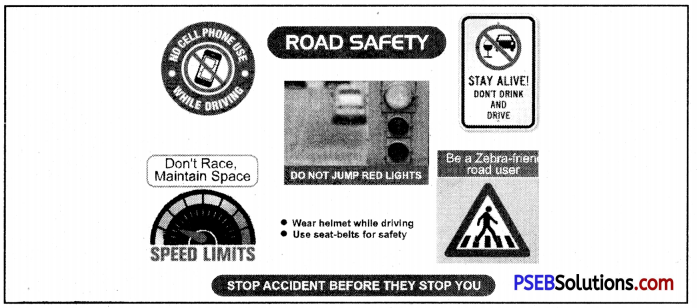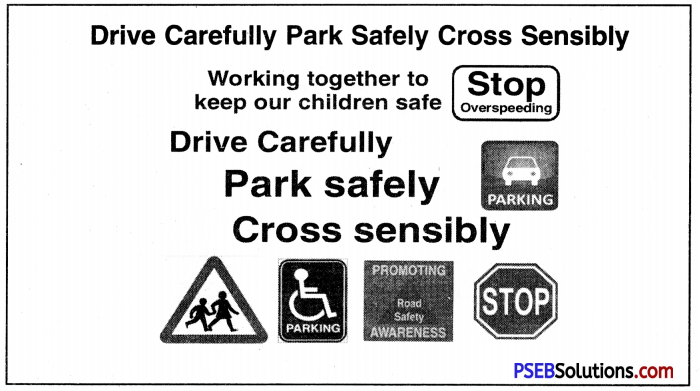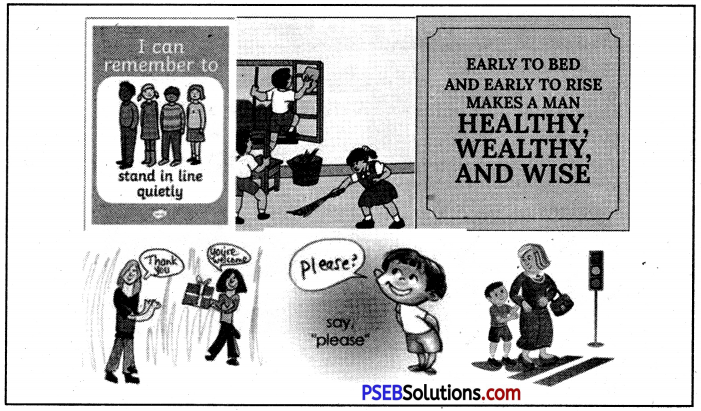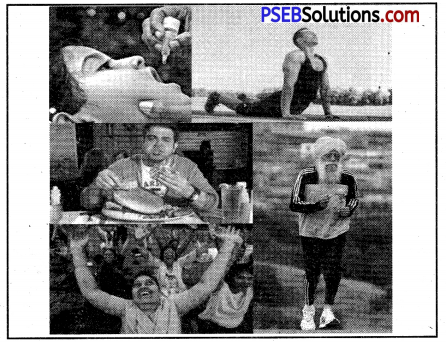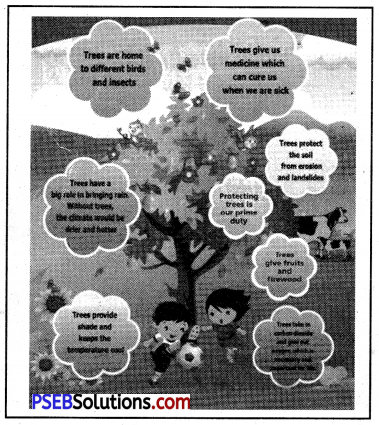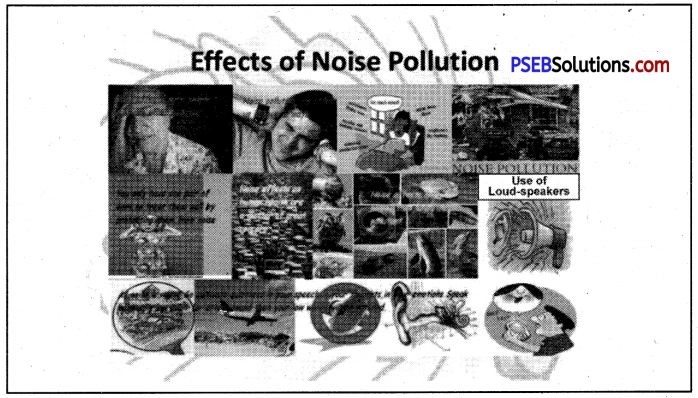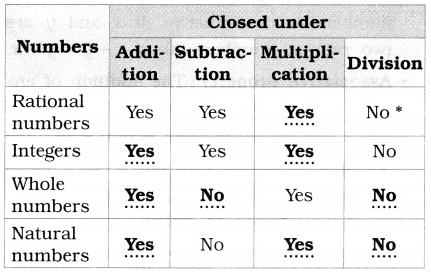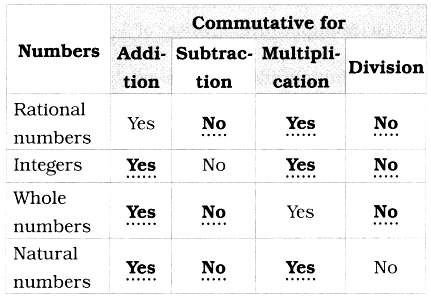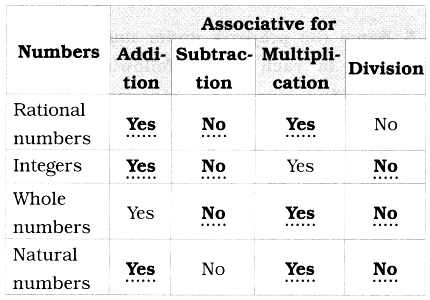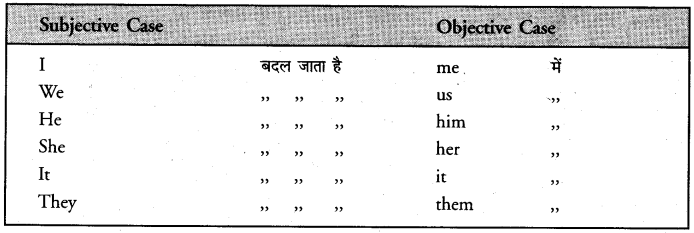Punjab State Board PSEB 8th Class English Book Solutions English Reading Comprehension Unseen Passages Exercise Questions and Answers, Notes.
PSEB 8th Class English Reading Comprehension Unseen Passages
I. Read the given passages and answer the questions that follow:
(1) Trees are as beautiful as they are useful. Wherever they are, they make that place look nice and green. They give us fruits, shade and wood. Birds build nests in their branches. Trees make the whole place like a garden. They are indeed nature’s precious gift to us.
Every tree is a living and breathing creature, like us. But unlike us, it prepares its own food from raw materials such as carbon dioxide, water and sunlight. Also, unlike us, it lacks a well-developed nervous system although it responds to many external stimuli. The, tree breathes through its leaves.
How does the environment affect the growth of the tree ? If there is a lack of water, the roots go down deeper and spread out far and wide, backward and forward, in search of food material. If there are too many trees in one place, they grow higher and higher to reach the sunshine. If there is a strong wind all the time, the tree takes firmer hold of the ground with its roots.
The tree is a strong fighter. It may bend before the wind but it does not always break. It protects itself very well against snow, frost and hail. It can defeat most of its enemies. But human beings defeat the tree every time by cutting it down. Litde do they know that by destroying trees at such a large scale, they are actually destroying themselves.
Question 1.
Trees are natures precious gift to us because:
(a) they provide us food, shade and wood
(b) they provide shelter to the birds
(c) they turn the earth into a beautiful place
(d) all of the above.
Answer:
(d) all of the above.
Question 2.
When there is lack of water, the tree:
(a) grow taller in order to get rain
(b) takes firm hold on the ground
(c) starts breathing through its leaves
(d) sends its roots deep, far and wide.
Answer:
(d) sends its roots deep, far and wide.

Question 3.
Which of the following statement is true for both humans and trees ?
(a) both breathe and grow
(b) both can move and run
(c) both buy their own food
(d) both have a nervous system.
Answer:
(a) both breathe and grow.
Question 4.
Trees fight many enemies but they are not able to defeat :
(a) snow
(b) wind
(c) water scarcity
(d) human beings
Answer:
(d) human beings.
Question 5.
Trees are strong fighters because :
(a) they can adapt themselves to all circumstances
(b) they can kill other trees for their growth
(c) they can defeat all their enemies
(d) they have strong roots and trunk.
Answer:
(a) they can adapt themselves to all circumstances.
(2) Schools all over India celebrate Childrens Day’ on 14th November every year. On this day, our great Prime Minister who had a great love for children was born. His ancestors came down from Kashmir to the rich plains below. Kaul had been his family name; this changed to Kaul-Nehru: and in later years. Kaul was dropped and they became simply Nehrus. Jawahar Lai Nehru was the only son of his prosperous parents. His two sisters were much younger to Jawahar Lai Nehru, And so, he grew up and spent his early years as a lonely child with no companion of his own age. Private tutors were in charge of his education. Then, he went to England and was educated at Harrow and at Trinity College, Cambridge.
Question 1.
Childrens Day is celebrated on:
(a) 15th August
(b) 26th January
(c) 14th November
(d) 30th January.
Answer:
(c) 14th November.
Question 2.
Nehrus ancestors came from:
(a) Delhi
(b) Allahabad
(c) Kashmir
(d) Raibareli.
Answer:
(c) Kashmir.
Question 3.
Jawahar Lai Nehru was educated at:
(a) Wilson College, Mumbai
(b) Harrow and Trinity College, Cambridge
(c) Presidency University, Kalkata
(d) Jesus and Mary College, Delhi.
Answer:
(b) Harrow and Trinity College, Cambridge.
Question 4.
Why is 14th November celebrated as Childrens Day ?
Or
What is the importance of 14th November ?
(a) Pt. Nehru was born on this day.
(b) Mahatma Gandhi was born on this day.
(c) Indira Gandhi was born on this day.
(d) None of the above.
Answer:
(a) Pt. Nehru was born on this day.
Question 5.
Nehru ji belonged to:
(a) a poor family
(b) a family of farmers
(c) a rich / prosperous family
(d) none of these.
Answer:
(c) a rich / prosperous family.
(3) Once a bee felt thirsty. It flew to a pond to drink water. While drinking water, the bee fell into the pond. A dove was sitting on the branch of a tree. It saw all and decided to save the bee’s life. The dove threw a leaf. The bee climbed over the leaf, dried its wings and flew away.
After a few days a hunter came to the forest. He aimed at the dove. Luckily the bee saw the hunter. It flew to the hunter and stung him hard on the hand. The hunter missed his aim. The dove heard the gunshot and flew away. The dove thanked the bee for this timely help.
Question 1.
Where did the bee fly to drink water ?
(a) a canal
(b) a pond
(c) a river
(d) a stream.
Answer:
(b) a pond
Question 2.
What happened to the bee while drinking water ?
(a) It fell from the tree
(b) It fell into the pond
(c) It was shot by the hunter
(d) None of the above.
Answer:
(b) It fell into the pond.
Question 3.
Who saved the bee’s life?
(a) a dove
(b) a hunter
(c) a fish
(d) a tortoise.
Answer:
(a) a dove.
Question 4.
What did the bee do to save the dove’s life?
(a) It killed the hunter
(b) It stung the hunter on the hand
(c) It shouted hard
(d) It did nothing.
Answer:
(b) It stung the hunter on the hand.
Question 5.
What is the moral of the story ?
(a) Do good, have good
(b) Revenge is the best policy
(c) Pride hath a fall
(d) Union is strength.
Answer:
(a) Do good, have good.
(4) Garbage is a great environmental hazard. It comes from various sources-used paper, tiffin packings, plastic bags, ice-cream wrappers, bottle caps, fallen leaves from trees and many more. Garbage makes the premises ugly, unkempt and breeds diseases.
A lot of trash that is thrown away contains material that can be recycled and reused such as paper, metals and glass which can be sent to the nearest recycling centre or disposed of to the junkdealer. It also contains organic matter such as leaves which can enrich land fertility.
A compost pit can be made at a convenient location where the refuse can be placed with layers of soil and and occasional sprinkling of water. This would help decomposition to make valuable manure (fertilizer). This would also prevent pollution that is usually caused by burning such organic waste.
Question 1.
Garbage is a great environmental hazard because it makes the premises:
(a) ugly
(b) unkempt
(c) breed diseases
(d) all these.
Answer:
(d) all these.
Question 2.
What happens to the disposed material at the recycling centre ?
(a) sent back to homes
(b) takes a new shape.
(c) thrown into rivers.
(d) all the above.
Answer:
(b) takes a new shape.

Question 3.
How can we make use of waste organic matter ?
(a) send it to junkdealer
(b) burn it
(c) change it into valuable manure (fertilizer)
(d) all these
Answer:
(c) change it into valuable manure (fertilizer.)
Question 4.
Proper disposal of garbage
(a) spreads pollution
(b) prevents pollution
(c) spoils mineral wealth
(d) none of these
Answer:
(b) prevents pollution.
Question 5.
The organic waste that can be recycled and reused is
(a) paper
(b) glass
(c) metals
(d) all these.
Answer:
(d) all these.
(5) Yoga is the ancient Indian system to keep a person fit in body and mind. It is basically a system of self-treatment. According to the yogic view, diseases, disorders and ailments are the result of some faulty ways of living, bad habits, lack of proper knowledge and unsuitable food. The diseases are thus the resultant state of a short or prolonged malfunctioning of the body system. The root cause of a disease lies in not correcting the mistakes by the same individual. The yogic practice of treatment comprises three steps, namely proper diet, proper yogic practice and proper knowledge of things concerning the self.
Question 1.
The benefit of the system of yoga is:
(a) It keeps a person fit in body and mind.
(b) It is a modern Indian system.
(c) It makes a person religious.
(d) Comprises three steps.
Answer:
(a) It keeps a person fit in body and mind.
Question 2.
What type of system is this basically?
(a) It is a costly treatment
(b) It is a self-treatment.
(c) It avoids bad habits.
(d) All of the above.
Answer:
(b) It is a self-treatment.
Or
Diseases, disorders and ailments are the results of
(a) Some faulty ways of living.
(b) Some normal ways of living
(c) Some cosdy ways of living.
(d) All of the above.
Answer:
(a) Some faulty ways of living.
Question 3.
What is the root cause of diseases ?
(a) Mistakes of the doctors.
(b) Mistakes of the parents.
(c) Mistakes of the governments.
(d) Mistakes of the individual.
Answer:
(d) Mistakes of the individual.
Question 4.
How many steps does yoga practice keep?
(a) Only one step.
(b) Only three steps.
(c) Only two steps.
(d) Only four steps.
Answer:
(b) Only three steps.
Or
Which is the first step of yoga?
(a) Proper yogic practice.
(b) Proper knowledge of things.
(c) Proper diet.
(d) Proper exercise of body.
Answer:
(c) Proper diet.
Question 5.
Which is the third step of yoga?
(a) Proper knowledge.
(b) Proper counselling.
(c) Proper thinking.
(d) None of the above.
Answer:
(a) Proper knowledge.
Or
Whose efforts cure the person ?
(a) The doctor’s efforts.
(b) The yoga experts efforts.
(c) The efforts of the society.
(d) The patients efforts.
Answer:
(d) The patients efforts.
(6) There is an incident which occurred at the examination during my first year at the high school. Mr. Giles, the Education Inspector, had come on a visit of inspection. He had set us five words, to write as a spelling exercise. One of the words was ‘ketde’. I had mis-spelt it. The teacher tried to prompt me with the point of his boot, but I would not be prompted. It was beyond me to see that he wanted me to copy the spelling from my neighbour’s slate for I had thought that the teacher was there to supervise us against copying.
Question 1.
When did the incident occur ?
(a) In the second year.
(b) In the first year.
(c) In the third year.
(d) None of the above.
Answer:
(b) In the first year.
Or
Who was the Education Inspector?
(a) Mr. Gordon
(b) Mr. Graham
(c) Mr. Giles
(d) Mr. George.
Answer:
(c) Mr. Giles
Question 2.
Which exercise was given to write?
(a) Dictation exercise.
(b) Handwriting exercise.
(c) Yoga exercise.
(d) Spelling exercise.
Answer:
(d) Spelling exercise
Or
How many words were given to us ?
(a) Three words.
(b) Five words.
(c) No word was given.
(d) Four words.
Answer:
(b) Five words.
Question 3.
Who tried to prompt the speaker/writer ?
(a) The teacher.
(b) The Inspector.
(c) The students.
(d) All of the above.
Answer:
(a) The teacher.
Or
What mistake had the writer committed ?
(a) A word mistake.
(b) A meaning mistake.
(c) A spelling mistake.
(d) A speaking mistake.
Answer:
(c) A spelling mistake.
Question 4.
What was the point of indication used by the teacher ?
(a) The point of his hand finger.
(b) The point of his right foot finger.
(c) The point of his left hand thumb.
(d) The point of his boot.
Answer:
(d) The point of his boot.

Question 5.
Which word was mis-spelt ?
(a) Kettle.
(b) Catde.
(c) Settle.
(d) Metal.
Answer:
(a) Kettle.
(7) People often curse poverty as a great evil, and it seems to be an accepted belief that if people only had plenty of money, they would be happy and useful and get more out of life. But the reality is that while palaces give a comfortable life, peace and contentment dwell in cottages. I always pity the sons and daughters of rich parents who are attended by servants and governesses. It is because I know how sweet and happy and pure the home of honest poverty is and how loving and united the members of poor families are in common interests. It is for these reasons that so many strong, eminent and self-reliant men have always sprung from poor families.
Question 1.
What do the people often think about the poverty?
(a) It is a curse and great evil.
(b) It is a boon of God.
(c) It is a self-created act.
(d) It is a social evil.
Answer:
(a) It is a curse and great evil.
Or
Who are attended by servants and governesses?
(a) The kings of the world.
(b) The members of the poor families.
(c) The sons and daughters of rich parents.
(d) None of the above.
Answer:
(b) The sons and daughters of rich parents.
Question 2.
Who are happy according to accepted belief ?
(a) People who have no money.
(b) People who have plenty of money.
(c) People who have a higher education.
(d) People who have no higher education.
Answer:
(a) People who have no money.
Or
What is the reality of happy life.
(a) To live in luxurious palaces.
(b) To live in the forests.
(c) To live peaceful and contented life in a hut.
(d) To live in the king’s palaces.
Answer:
(c) To live peaceful and contented life in a hut.
Question 3.
What does the home of poverty provide us?
(a) A life of prosperity.
(b) A sweet, happy and pure home.
(c) A dirty, bad and disturbed life.
(d) A life of dissatisfaction.
Answer:
(b) A sweet, happy and pure home.
Question 4.
Whose members are loving and united ?
(a) Members of poor families.
(b) Members of rich families.
(c) Members of tribal families.
(d) Members of royal families.
Answer:
(a) Members of poor families.
Or
Who have sprung from poor families ?
(a) Weak, cowardly and religious persons.
(b) Educated, rich and royal persons.
(c) Prosperous honoured and noble persons.
(d) Strong, eminent and self-reliant persons.
Answer:
(d) Strong, eminent and self-reliant persons.
Question 5.
Whose plus points are highlighted in the passage ?
(a) The rich.
(b) The noble,
(c) The honoured.
(d) The poor.
Answer:
(d) The poor.
(8) Books have much value in our life. They are our lifeline and best companion. Everything comes to an end but they live for ever. They never deceive the readers. They help us in difficulties. We get much knowledge and entertainment from them. We get new meanings and beauties in books. By reading books, we just get confidence in life. This world would be quite dark without books. They tell us about people, their culture and profession.
Question 1.
Books have:
(a) no value.
(b) less value.
(c) much value.
(d) different value.
Answer:
(c) much value.
Or
Books are our:
(a) lifeline.
(b) best companion.
(c) companion and enemy
(d) both (a) and (b).
Answer:
(d) both (a) and
(b) lifeline and best companion.

Question 2.
A quality of books is:
(a) They come to an end.
(b) They don’t live for ever.
(c) They live for ever.
(d) All the above.
Answer:
(c) They live for ever.
Or
Books help us:
(a) in trouble.
(b) in difficulties.
(c) Both (a) and (b).
(d) in sorrows.
Answer:
(b) in difficulties.
Question 3.
We get from books:
(a) waste paper
(b) much knowledge.
(c) entertainment.
(d) Both (b) and (c).
Answer:
(d) both (b) and (c) much knowledge and entertainment.
Or
By reading books we get:
(a) confidence in life
(b) difficulties in life
(c) popularity and prosperity
(d) All the above.
Answer:
(a) confidence in life.
Question 4.
Without books the world would become:
(a) quite happy.
(b) quite bright.
(c) quite dark.
(d) Both (a) and (b).
Answer:
(c) quite dark.
Question 5.
Books tell us about:
(a) people.
(b) their culture.
(c) their profession.
(d) All the above.
Answer:
(d) All the above.
(9) Diwali is the greatest festival of Hindus. It is celebrated throughout the world. It is a festival of lights and candles. It comes in the month of October or November every year. On this day people worship Goddess Lakshmi. They put on new clothes and buy sweets. They also give presents to their friends and relatives. Some people gamble on this day which is an evil practice. Children play crackers and fireworks.
Question 1.
Diwali is the greatest festival of
(a) Muslims
(b) the poor
(c) the rich
(d) Hindus
Answer:
(d) Hindus
Question 2.
Diwali is celebrated:
(a) only in India.
(b) throughout Asia
(c) throughout the world.
(d) None of these.
Answer:
(c) throughout the world.
Or
Diwali is a festival of:
(a) lights.
(b) Candles
(c) swings
(d) both (a) and (b)
Answer:
(d) both (a) and (b) lights and candles.
Question 3.
Diwali fells in the month of:
(a) October.
(b) October or November.
(c) December
(d) None of these.
Answer:
(b) October or November.
Or
On this day people worship:
(a) Goddess Kali.
(b) Goddess Lakshmi.
(c) Both (a) and (b).
(d) None of these.
Answer:
(b) Goddess Lakshmi.

Question 4.
On this day people:
(a) buy houses
(b) buy sweets.
(c) give up bad habbits
(d) All the above.
Answer:
(b) buy sweets.
Or
An evil practice related to Diwali is:
(a) drinking
(b) fighting
(c) smoking
(d) gambling.
Answer:
(d) gambling
Question 5.
Who plays cracker and fire works on this day ?
(a) rich people
(b) poor people
(c) Children
(d) Goddess Laxmi
Answer:
(c) Children
(10) Mohan and Sohan were fast friends. Mohan was very selfish and cunning while Sohan was very loyal and dependable. One day they set out on a long journey. Both decided to help each other. While crossing the forest, they saw a bear coming towards them. Mohan at once climbed up a tree. But Sohan did not know how to climb up. He lay on the ground and held his breath. The bear came and took Sohan as dead. After the bear had gone, Mohan came down the tree and asked Sohan what the bear had said in his ear. Sohan replied that the bear had told him never to trust a false friend.
Question 1.
Mohan was:
(a) loyal.
(b) very helpful.
(c) very selfish and cunning.
(d) All the above.
Answer:
(c) very selfish and cunning.
Question 2.
Sohan was very:
(a) selfish.
(b) cunning.
(c) loyal and dependable.
(d) a false friend
Answer:
(c) loyal and dependable.
Question 3.
One day Mohan and Sohan set out:
(a) on a tour.
(b) on a long journey.
(c) on an expedition.
(d) on a short trip.
Answer:
(b) on a long journey.
Question 4.
What did they see in the forest?
(a) An elephant.
(b) A lion.
(c) A tiger.
(d) A bear.
Answer:
(d) A bear.
Or
What did Sohan do?
(a) He ran away.
(b) He lay on the ground.
(c) He held his breath.
(d) Both (b) and (c).
Answer:
(d) both (b) and (c) He lay on the ground and held his breath.

Question 5.
What did the bear do ?
(a) It attacked Sohan.
(b) It killed Sohan.
(c) It took Sohan as dead.
(d) It took Mohan as dead
Answer:
(c) It took Sohan as dead.
Or
The bear had told Sohan not to
(a) trust anybody.
(b) climb up a tree.
(c) go on a journey.
(d) trust a false friend.
Answer:
(d) trust a false friend.
(11) His first ‘Satyagraha in India was in Champaran, in Bihar. The peasants of that district were being cruelly treated by the British indigo planters. Gandhiji left for Champaran to find out the truth. The news that a Mahatma had arrived to inquire into their sufferings attracted thousands of peasants who flocked to Champaran to have has darshan. The Government got alarmed and Gandhiji was asked to leave the district. He refused and was asked to appear before magistrate. Later, the case was withdrawn.Gandhiji lived with the peasants for some time in order to learn about their hard lot. But, he also taught them to be free and to stand on their feet. At last, he succeeded in securing justice for the poor peasants.
Question 1.
Gandhiji left for Champaran to find
(a) out the truth
(b) out the peasants
(c) out the magistrate
(d) none of the above.
Answer:
(a) out the truth.
Question 2.
Who were cruelly treated ?
(a) The British indigo planters
(b) Gandhiji and his followers
(c) The peasants of Champaran
(d) The peasants all over India
Answer:
(c) The peasants of Champaran.
Question 3.
Gandhiji was asked to leave because:
(a) his life was in danger.
(b) the government was alarmed.
(c) he had lost his energy to unite the peasants.
(d) all the above.
Answer:
(b) the government was alarmed.
Question 4.
When refused, Gandhiji was asked to appear before:
(a) the peasants
(b) the public meeting
(c) the indigo planters
(d) the magistrate.
Answer:
(d) the magistrate.
Question 5.
Gandhiji’s first ‘Satyagraha’ was a:
(a) success
(b) failure
(c) false show
(d) poor show
Answer:
(a) success.
![]()
![]()
![]()

